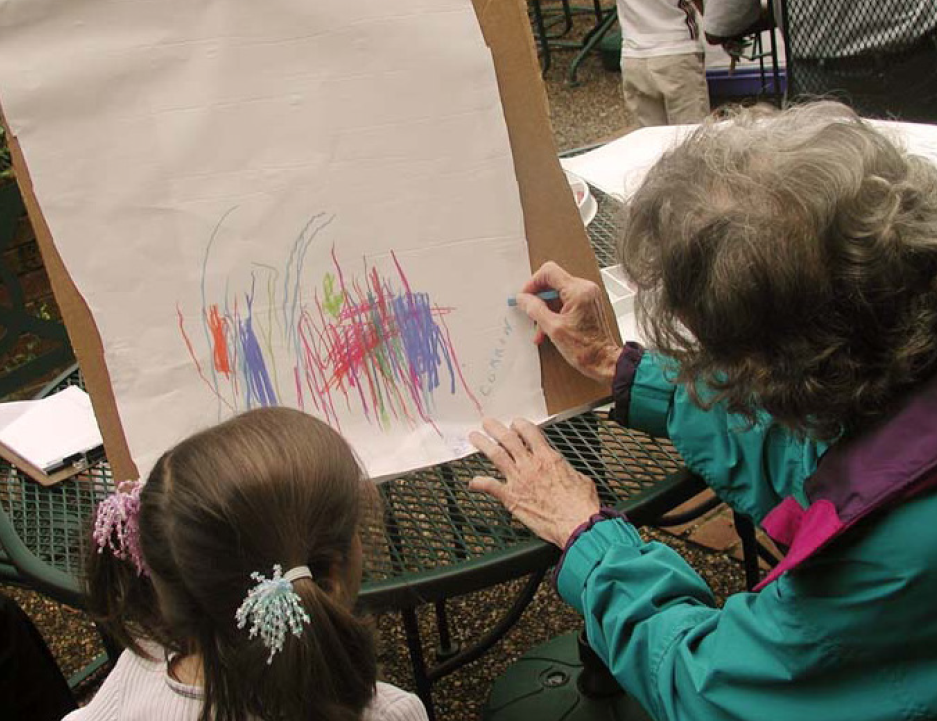Best Practices in Intergenerational Programming: Practice 4
ID
FCS-37P (FCS-81P)

Participants are prepared ahead of time and reflect on activities afterward.
Practice 4 • Preparing participants
Intergenerational programs are most effective when participants are prepared ahead of time and reflect on activities afterward.
It is important for staff members to inform intergenerational participants of the nature of the activity and the expectations concerning their roles and responsibilities. Describing the activity to participants ahead of time allows them to mentally prepare for the experience.
For children, expectations help to guide their behavior and prepare them for learning. For adults, the preparation allows them to feel in control so they are not blindsided by what is to come. After the activity, both groups should reflect either together or separately.
Reflection is simply getting participants to talk about their experience. Reflection is a critical component of learning for adults and children.
Reflecting with children allows them to rename, restate, and revise actions for the next time they try similar tasks. Through reflection, adults may transform their assumptions about involvement and feel that their input is valuable.
Application of the Practice
When facilitators take the time to reflect with and listen to participants, there is an empowering effect for participants. Listening to reflections is a way to consider valuable input that can be used to redesign activities for the future or to help staff choose how to pair participants.
In addition to reflection through discussion, try to role-play the activity or reflect on it or discuss it in pairs.

Program Ideas
- During reflection, asking the right questions is a skill. If participants roll their eyes when asked to reflect or simply do not participate, don’t give up. Perhaps they need additional guidance and more- pertinent questions.
- Create a supportive environment for group reflection to occur. Consider using the same type of setting each time (room arrangement, lighting, a centerpiece, etc.) for a cue that it is time for reflection.
- Reinforce reflections. See every idea as a good one. Don’t interrupt reflections, but help discussion stay focused.
- Clarify, restate, paraphrase, and ask for more information.
- Use open-ended questions. For example: What did you notice about the children today? How did the adults like what we did? What else might we do like this the next time? Which part of working together did you like?
Best Practices for Intergenerational Programming
- Staff members of the adult and child programs collaborate to plan activities.
- Participants are involved in decision-making about the activity and during activities.
- Participation is voluntary.
- Participants are prepared ahead of time and reflect on the activity afterward.
- Activities reflect interests, backgrounds, and social histories of program participants.
- Activities are age- and role-appropriate.
- Activities support interaction among intergenerational participants.
- Facilitators skillfully stage the environment to promote interaction.
- Facilitators consider the social environment and the role of staff members.
- Adaptive equipment is used as appropriate.
- Facilitators document and communicate experiences to build on in future activities.
Additional Resource
Reed, J., and C. Koliba. 2012. Facilitating Reflection: A Manual for Leaders and Educators.
John Dewey Project. University of Vermont. www.uvm.edu/~dewey/reflection_manual/.
Reference
Jarrott, S. E. 2011. “Where Have We Been and Where Are We Going? Content Analysis of Evaluation Research of Intergenerational Programs.” Journal of Intergenerational Relationships 9:37-52. doi:10.1080/15350770.2011.544594.
Project TRIP
Transforming Relationships Through Intergenerational Programming
A Children’s, Youth, and Families at Risk project of Virginia Tech with the Jefferson Area Board for Aging and the YMCAs of Charlottesville and Louisa County, Va.
Shannon Jarrott, Associate Professor, Human Development, Virginia Tech
Karen DeBord, Extension Specialist, Family and Human Development, Virginia Tech
Reviewed by Crystal Tyler-Mackey, Extension Specialist, Community viability, Virginia Tech
Contact: Shannon Jarrott, sjarrott@vt.edu
This is one of 11 fact sheets on the emerging best practices associated with intergenerational programs.
Intergenerational programs are those that connect younger and older generations to foster positive experiences. Research continues to grow, noting that when successfully delivered, intergenerational programs result in positive health eects, child learning, and appropriate socialization for both young and old (Jarrott 2011).
The fourth practice relates to preparing the participants prior to the activity.
Virginia Cooperative Extension materials are available for public use, reprint, or citation without further permission, provided the use includes credit to the author and to Virginia Cooperative Extension, Virginia Tech, and Virginia State University.
Virginia Cooperative Extension is a partnership of Virginia Tech, Virginia State University, the U.S. Department of Agriculture (USDA), and local governments, and is an equal opportunity employer. For the full non-discrimination statement, please visit ext.vt.edu/accessibility.
Publication Date
May 3, 2019



